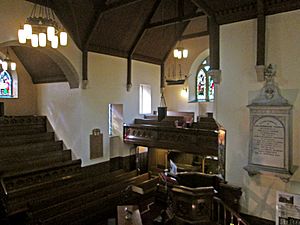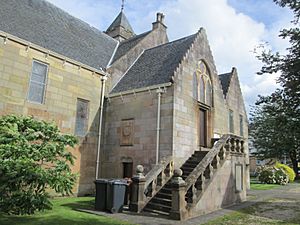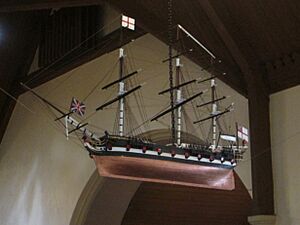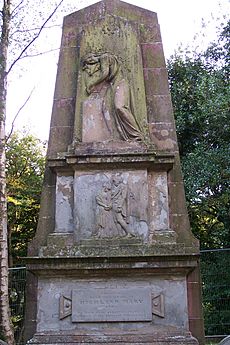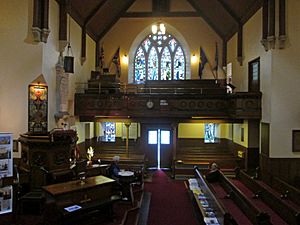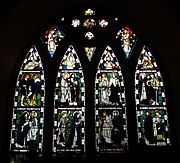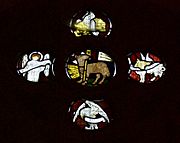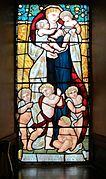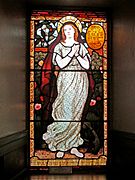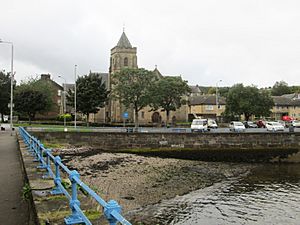Old West Kirk facts for kids
The Old West Kirk is a historic church in Greenock, Scotland. It was first opened in 1591 and is famous for being the very first Presbyterian church built in Scotland after the Scottish Reformation. It was also the first church of its kind to be approved by the Scottish Parliament.
Over many years, the town of Greenock grew around the church. The church itself was made bigger, and special viewing areas called galleries were added so more people could attend services. As the population grew, other churches were built starting in 1761.
In 1841, the Old West Kirk closed because its congregation moved to a new church. The old building became run-down, but it was beautifully restored and reopened on Christmas Day in 1864. An architect named James Salmon oversaw the work and added a tower. The church then became home to a wonderful collection of Pre-Raphaelite stained glass windows.
Later, shipyards grew up near the church. In 1917, a company called Harland and Wolff wanted to expand their shipyard into the churchyard. They offered a new location for the church further along the coast. They also built a church hall, called the Pirrie Hall, which the congregation used temporarily. The Old West Kirk was carefully taken apart and rebuilt at its new spot on the Esplanade in Greenock, opening there in January 1928.
In 2011, the Old West Kirk joined with two other churches to form the Lyle Kirk, Greenock. For a while, it was open to the public when cruise ships visited Greenock, offering guided tours. However, these tours stopped when the COVID-19 pandemic began.
Quick facts for kids Old West Kirk |
|
|---|---|
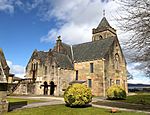
Old West Kirk at the Esplanade, Greenock
|
|
| 55°57′22″N 4°46′02″W / 55.956013°N 4.767263°W | |
| Country | Scotland |
| Denomination | Church of Scotland |
| Churchmanship | Presbyterian |
| Website | Lyle Kirk Greenock Website |
| History | |
| Founded | 1591 |
| Architecture | |
| Heritage designation | Category B |
| Designated | 1971 |
| Administration | |
| Presbytery | Greenock and Paisley |
Contents
Early History of Greenock
The land of Greenock was located along the southern shore of the River Clyde estuary. This is where the river opens up into the wider Firth of Clyde. Around the year 1400, a man named Malcolm Galbraith passed away without sons. His land in Greenock was then divided between his two daughters.
The older daughter married into the Crawfurd family and received Easter Greenock Castle. The younger daughter married into the Schaw family and received Wester Greenock. Around 1540, the nearby area of Finnart also became part of the Schaw family's land. This extended their property westward towards Gourock. In 1542, John Schaw built Wester Greenock castle.
At this time, there wasn't a proper village. People who worked for the castles lived there. Most other residents were fishing families living in simple homes along the coast. There were a few small churches, like one at Chapelton and another called St. Lawrence. The name Kilblain also suggests there might have been a small church for Saint Blane nearby.
Founding the Church
The Scottish Reformation in 1560 led to the closure of the small churches in Greenock. The main church for the area was then about 5.5 miles away in Inverkip. This meant an 11-mile round trip over tough land for people to attend services. A church group later noted that the distance was "four long miles with many big streams and waters that were impossible to cross in winter." They also noted that many people lived there.
John Schaw of Greenock used his influence with the king to solve this problem. On November 18, 1589, King James VI of Scotland signed a special document. This document allowed Schaw to build a church, a minister's house, and a graveyard. The King was impressed by Schaw's strong desire to help the "poor people" who lived on his land. These people were mostly fishers and lived "four miles from their parish church," with a "great river to cross." The King wanted them to have "ease in winter season."
The church was then built. It cost about 3,000 merks Scots, which was around £166 in British money at the time. It officially opened on October 4, 1591. This was a very important event because it was the first Presbyterian church built in Scotland after the Scottish Reformation.
In 1592, the Parliament of Scotland passed a law approving the church built by John Schaw. This made it the first Presbyterian church confirmed by the parliament. Another law in 1594 separated Schaw's lands from Inverkip and made them part of the new parish of Greenock. John Schaw passed away in 1593. He might have been buried under the east part of the church.
Original Design and Changes
The church stood in its graveyard near the sea, next to the West Burn. The minister's house was to the north of the graveyard. The church's main rectangular part, called the nave, ran roughly north to south. The entrance was at the south end. Inside, a path about 6 feet wide ran from the entrance to the north wall. A long communion table was placed along this path.
The main floor was made of earth, later covered by open wooden slats. Coins sometimes fell through these slats. The church windows had clear glass, and the walls inside were painted white. The ceiling was flat and made of plaster.
Later, sections called aisles were added to the east and west sides. These additions made the church look like a cross, which is called a cruciform plan. It's thought that the east aisle was built in 1591. The west aisle might have been built at the same time.
Church Expansion
A fishing community grew near the church. Around 1654, maps showed "Grinok toune." From 1671, the village of Cartsdyke also developed nearby.
The church started to get too small for the growing number of people. In 1635, when the parish was made larger, the "Laird of Kilburnie" offered to make the south aisle bigger. In 1674, another landowner, Craufurd of Cartsburn, offered to help pay for making the church larger. He also offered to help build a new minister's house and a school.
Around 1696, the west aisle and north end were extended by about 15 feet. The south end was extended by 10 feet. This made the cross-shaped church about 74 feet from north to south and 63 feet across the side sections. A new two-story part was added to the north side of the Schaw aisle. The ground floor of this new section was used as a place to keep bodies.
Special viewing areas called lofts or galleries were added above the main floor. In 1697, permission was given to build the Sailors' Loft above the south aisle. The Farmer's Loft was built above the north aisle. The west gallery was called the Cartsburn Loft. The church had seven doors, including ones that led to outside stairs for the galleries.
Greenock grew even more after its harbour was built in 1710. Shipbuilding also began in 1711. By 1729, there were plans for a second church. The Mid Kirk opened in 1761. At this point, the original church became known as the Old Parish Church, and later the West Parish Church. More churches were built from 1774 onwards. In 1767, the walls of the West church were raised by about 3.5 feet before the roof was replaced.
Decline and Closure in 1841
The churchyard was made bigger in 1657 and 1721 to create more burial space. However, in 1773, there wasn't enough land for further expansion. After a long legal dispute, a new cemetery was opened in 1786. This is where John Galt, a famous novelist, is buried.
Mary Campbell (Highland Mary), who was a love of the poet Robert Burns, died in Greenock around October 1786. She was visiting her brother when she became ill, likely with typhus. She was buried in the Old West Kirk churchyard.
The church itself became damp and unhealthy because the graveyard was higher than its floor. In 1835, people asked for improvements, but it was decided that building a new church would be cheaper. A new site was chosen in 1838. In 1841, the old church closed, and the congregation moved to the new West Church.
During the Disruption of 1843, the minister and most of the congregation from the Gaelic Parish joined the Free Church. They used the old kirk temporarily while their new church was being built. After that, the Old West Kirk was empty again and fell into disrepair.
Restored in 1864
At first, people thought it was impossible to restore the old kirk. But money was raised, and extensive restoration work began in 1864. Architect James Salmon oversaw the project. The inside of the church was completely redone. The old earthen floor was dug out, and a new waterproof layer was put down. During this work, over 70 copper coins and two silver coins were found.
The outside walls were rebuilt in some places. A new church tower, designed by Salmon, was also added. This tower included stairs for the Cartsburn Loft and the Farmer's Loft, replacing the old outside stairs. The walls inside were painted a warm cream color, and the roof had dark stained timber. The church reopened on Christmas Day, 1864.
In 1872, the kirk was officially named the North Parish Church, but people still called it the Old West Kirk. The galleries inside were now more steeply sloped. The Cartsburn gallery was rebuilt in 1873, and an organ was installed there in 1874. The Schaw aisle, then called the Sir Michael's gallery, was also rebuilt.
Beautiful Stained Glass Windows
The kirk gained a wonderful collection of Pre-Raphaelite stained glass windows. This happened thanks to Allan Park Paton, a librarian in Greenock. He contacted famous artists like Dante Gabriel Rossetti and William Morris.
The largest window in the church, at the Cartsburn end, was made by Morris & Co. and designed by Edward Burne-Jones. It shows the "Adoration of the Lamb" and features nearly thirty figures, including 16 biblical characters. Morris & Co. also provided two smaller windows by Burne-Jones, showing Faith and Music. A window by Rossetti, called Charity (or Caritas), was installed in 1868.
Another window, showing Hope with her Anchor, was added in 1884 by Daniel Cottier. Other windows in the church were made by Ballantine & Co. of Edinburgh.
Moving to the Esplanade
From 1711, John Scott began building ships near the church. Over time, shipyards took up more and more land between the churchyard and the Clyde River. In 1917, Harland and Wolff took over a shipyard close to the church. They wanted to expand their shipyard greatly, which meant taking over the church and its graveyard.
Harland and Wolff offered a generous deal. They provided a new site about half a mile further west along the coast, on Greenock's Esplanade. They also agreed to have the church carefully taken down and rebuilt. This work was supervised by architect James Miller. A new tower was built to Miller's design. The church was also turned around, so its main entrance now faced north-east.
The churchyard had been used as a cemetery from 1592 until it closed in 1857. The remains of the burials were moved to a large grave in Greenock's central Cemetery. However, the grave of Mary Campbell (Highland Mary) was treated specially. Her monument was moved from the old churchyard to Greenock Cemetery. Mary's remains were re-buried there on November 13, 1920, in a special ceremony.
Lord Pirrie of Harland and Wolff helped arrange the move. He also arranged for a new church hall to be built at the new site. This hall would be used by the congregation while the church was being rebuilt. Lord Pirrie passed away before this happened. The Pirrie Hall, named after him, opened on February 19, 1925. It served as a temporary place of worship.
The stones of the old kirk were carefully numbered, cleaned, and moved to the new site. The original Presbyterian church had no decorations, but hidden carvings of birds, fish, and animals were found on the stones. Rebuilding work began in March 1926 and finished in January 1928.
The kirk continued to be used fully until 2011. At that time, it joined with two other churches to form the Lyle Kirk, Greenock, which is part of the Church of Scotland.
Sale of the Property
In August 2022, the Church of Scotland put the property up for sale. This included the church building and the Pirrie Hall. Local groups, including the Old West Kirk Trust and Inverclyde Heritage Network, are trying to raise money to buy the Kirk and other buildings.
See also
- List of listed buildings in Greenock


